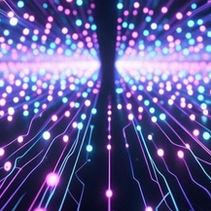The Power of Portability
- Sheila Lam

- Apr 26, 2024
- 5 min read
Updated: Apr 27, 2024
Taking advantage of the distributed cloud platform to move the right workload to the right cloud dynamically
In an Executive Panel Discussion by Akamai on April 17, speakers shared their views on The Power of Portability: Matching High-Performance Zero-Latency Workloads with the Right Cloud
Scale and speed matter in the new world of digitalization. The ability to instantly bring live interactions across multiple markets can make or break a digital business. But in the real world, unpredictable network performance, restricted cloud portability, and escalating infrastructure costs are slowing growth.
To support digital businesses driving growth with scale and speed, Inno-Thought recently gathered technology experts and practitioners to share insights on embracing portability in operations, data, and the cloud.

From left:
1. Wentao Li, Head of Cloud Solution Architects - Asia, Akamai Technologies
2. Chirag Desai, Head of IT Digital & Channels Solutions, The Hong Kong Jockey Club
3. Jay Jenkins, Chief Technology Officer, Cloud Computing Services, Akamai Technologies
4. Jeremy Fetiveau, Associate Partner, Transformation, Growth & Innovation, Sia Partners
5. Moderator: Sheila Lam, Editorial Consultant, Inno-Thought eNews
Customer-centricity and data gravity

"When I talk about portability, I'm not just talking about technical portability; I'm also looking at operational portability and scale portability," said Jay Jenkins, CTO, Cloud Computing Services, Akamai Technologies.
To achieve such multiple layers of portability, he said businesses should recognize the significance of customer-centricity and data gravity. More customers are expecting instant gratification and consistent experience. This forces businesses to operate their systems closer to the customers and process the data near the business activities.
Hong Kong Jockey Club (HKJC) has first-hand experience with the significance of exceptional customer experience. The club processes billions of dollars of bets on each race day, and the stakes are high if there is any delay or error.

"Gambling is all about timing. You have to provide the right price and deal at the right time," said Chirag Desai, Head of IT Digital & Channels Solutions, The Hong Kong Jockey Club. "If you short-change them or lose their money, you lose their trust."
In addition, the club collects a tremendous amount of data on each horse—their health condition, jockey, and performance—and then processes it to derive betting odds and statistics. HKJC also needs to provide this data in real time to local customers, overseas viewers, and betters.
"Similar to live Formula One race, where they are taking raw footage and real-time data broadcasting it around the world," said Desai. "All these require data to be broadcasted [anywhere] very quickly."
All these requirements leave the club no room for errors, as any outage or delay could cause a significant loss of customer and trust worldwide.
Enabling digital-native customers locally and globally

On top of HKJC, more digital-native businesses, like e-commerce or food delivery providers, are facing similar challenges, according to Jeremy Fetiveau, Associate Partner, Transformation, Growth & Innovation from Sia Partners.
When major rain storms hit, the demand for food delivery services could spike quickly. Similar issues also apply to e-commerce providers during Single Days, where customers worldwide could drive traffic 100 times higher. This spike could lead to slow website speeds, causing customers to abandon their shopping carts and move to the competitors.
"They have to be ready for these very short moments where traffic is exponential," said Fetiveau. "This is why online-first businesses rely heavily on cloud technologies."
The list of digital-native businesses relying on cloud technologies keeps growing, particularly with the rise of AI, Fintech, and Web3. These digital services often require low-latency networks and high-volume data processing to serve customers from distributed locations. "So they need the service to be very reliable and able to scale it wherever you need this conversation to happen," added Fetiveau.
While traditional cloud technologies have been beneficial for scaling up and down computing power dynamically, Jenkins said they also have a limitation of reaching customers based on the location and number of data centers available. This means businesses need to make choices regarding limited locations for customer support and the cost involved for each location.
"Businesses are then forced to compromise their [cloud] architecture based on the cost structure, which is a horrible place to be," he said.
The game-changing distributed cloud

This is why a distributed cloud architecture is a game-changer for digital businesses, noted Wentao Li, Head of Cloud Solution Architects Asia, Akamai Technologies.
Design to support data centers across multiple geographic locations with accelerating speed, a distributed cloud architecture is an optimizer for traditional cloud technologies. Jenkins added Akamai Connected Cloud, the company's distributed cloud network, covers 750 cities from 130 countries. "We also have 4,100 edge [computing] locations, eight times more than any other cloud provider," he added.
Apart from providing multiple physical locations, Li said Akamai Connected Cloud also maximizes the value of cloud-native applications. These loosely-coupled microservice-oriented applications are built to support the agility to move workloads between clouds. But in reality, hyperscale cloud providers could limit portability through their platform-centric cloud model.
Li added while many businesses find hyperscale convenient, a distributed cloud architecture enables businesses to move the right workload to the right cloud, realizing the full potential of cloud-native applications.
"You could run your more data-intensive workloads on a lower-cost provider," said Li. "You could then choose another cloud provider for low latency and to meet data sovereignty requirements."
Li added simply transferring data from one cloud location to another within the same hyperscaler ecosystem could also be costly. A distributed cloud architecture further optimizes cloud spend by lowering egress costs, provides a truly cloud-agnostic multicloud operation.
4A1S

With a distributed cloud architecture, digital businesses can support their customers with any cloud anytime from anywhere using any device security. According to Victor Wong, Regional General Manager, Taiwan and Hong Kong, Akamai Technologies, that is the essence of supporting the business with 4A1S—any cloud, anytime, anywhere, any device, and security.
"No matter what you are building next and how you plan the cloud architecture, it is crucial to remember this principle 4A1S," said Wong.
Related resources

[Video] The Power of Portability: Matching High-Performance Zero-Latency Workloads with the Right Cloud.
To support digital businesses driving growth with scale and speed, Inno-Thought recently gathered technology experts and practitioners to share insights on embracing portability in operations, data, and the cloud ...... Watch now
More articles













































Comments